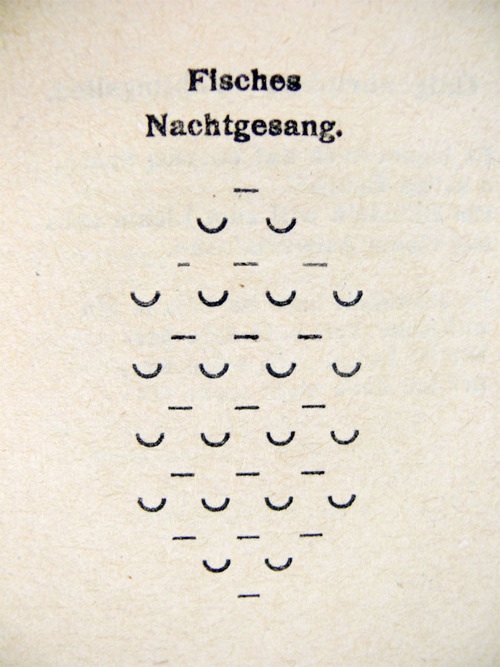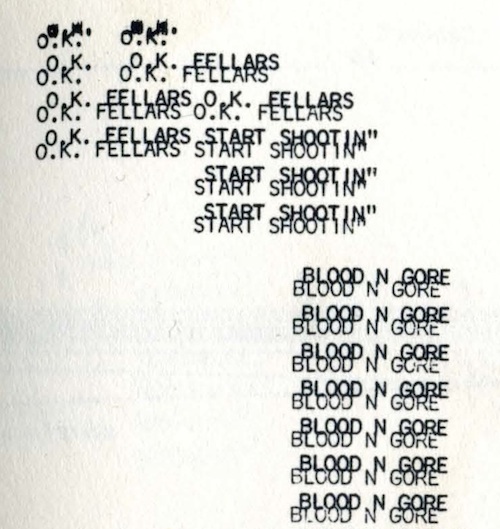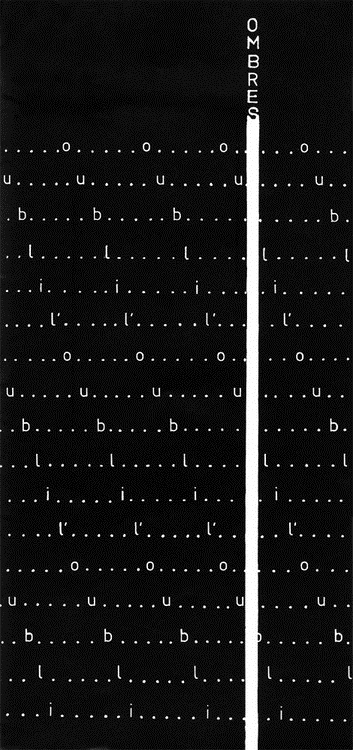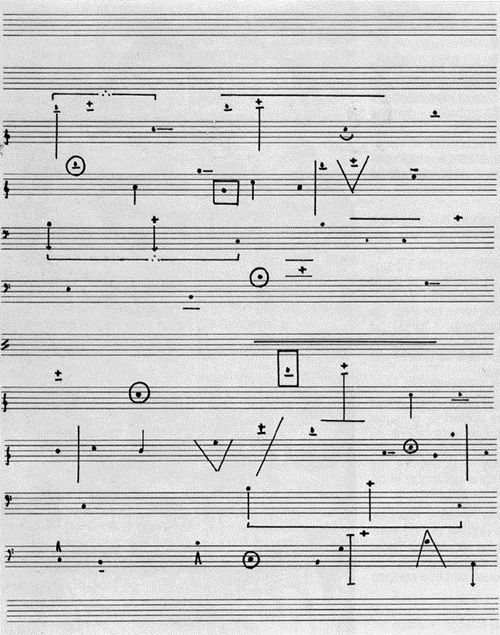A Bowerbird Event at The Rotunda 4014 Walnut Street Philadelphia, PA on April 19th, 2013; 8pm. Featuring: Caleb Beckwith Timothy Leonido Kate McGuire John Paetsch Danny Snelson Copy:
As Joan La Barbara reminds us, voice is the original instrument. Already in 1641, Jonson foresees the future of human prosody — it is the vocal apparatus running and sliding through its most fundamental operations. While Jonson here criticizes the senseless poetry of his contemporaries, what might occur if we take this statement seriously? What emerges when the vocal apparatus goes beyond sense, when it runs and slides and only makes a sound? To revel in this question, join us for an evening of sound poetry, featuring an exciting array of emerging poets performing historical works alongside contemporary experiments at the limits of the voice. From Raoul Hausmann through Christian Bök, from Henri Chopin to chris cheek, sound poets have devised some of the most adventurous writing on record, in only the most extreme forms of vocal performance. For those uninitiated to the sound poetry tradition, along with those more seasoned prosodic travelers, this program's set of live performances, micro-lectures, and instantaneous digital publications promise both to delight and to inform. Testing the "catalog of effects" at play in the practice of sound poetry, this event queries a broad database of historical forms to consider potentials for the contemporary application of poetic performance.
|
Raoul Hausmann: Phonemes (15:58)
Recorded in 1956 / 1957 by Henri Chopin
Henri Chopin: Espaces et gestes Charles Amirkhanian: Heavy Aspirations (1973) 38th and 39th Merzgedichte in Memoriam Kurt Schwitters (1:53) by Jackson Mac Low and Anne Tardos, 1993. Voices: Jackson Mac Low, Anne Tardos Robert Ashley performing John Barton Wolgamot's "In Sara Mencken, Christ and Beethoveen there were men and women" (1972) Francois Dufrene: Crirythme pour Bob Cobbing Harry Polkinhorn: Machine Clark Coolidge: Preface (1968 excerpted) John Giorno: Give it to me baby (1967) Charles Dodge: Speech Songs (1973-excerpts: no.1 When I am with you/no.2 He Destroys her image) Aram Saroyan: Crickets (1965) [recorded in the wind-off grooves of side two of 10 + 2=12 American Text-Sound Pieces (1974)] Tomomi Adachi: "Gamp" Tony McAulay "Collaborative Poem" (5:56) Marie Osmond performing Hugo Ball's "Karawane" Caroline Bergvall: "The Franker Tale (deus hic, 2)" Charles Bernstein: 1-100, 1969, (3:00) Jaap Blonk: Flux-de-Bouche, 1992 Jaap Blonk: Nonomotithur by Guy de Cointet, 1998 (2:09) Lars-Gunnar Bodin: CYBO II, 1967 (5'51) Christian Bök: Ubu Hubbub (:46) William S. Burroughs: Abandoned Artifacts from TALK TALK, Vol. 3, No. 6, September/October 1981 Owen Sound: 1'54" to ... Henri Chopin: La civilisation du papier (1975), 7:07 Carlfriedrich Claus: Laugtgedichten (1965) (4:12) Spontaneous Appealinair Contemprate Apollinaire (Voices: Bob Cobbing and Francois Dufrene) (3:12) Various Throats: Volume One (1988) Bob Cobbing (Voices: Bob Cobbing, Keith Musgrove, Steven Smith) - Duplicator Print Neil Mills: Seven Number Poems Charles Verey (1971): r t e p gr a Paula Claire (1971): Energygalaxy Tristan Tzara / Marcel Janco / Richard Huelsenbeck: L'amiral cherche une maison a louer, 1916, performed by Trio Exvoco (Hanna Aurbacher, Theophil Maier, and Ewald Liska) Raoul Hausmann: Soundrel, 1919 Francois Dufrene: Batteries vocales" Crirythme (1958) Francois Dufrene: Köchel que j'aime (9:36) Alvin Lucier: "North American Time Capsule 1967 (For Voices and Sylvania Electronic Systems Vocoder)" Toshi Ichyanagi: "Extended Voices (For Voices With Moog Synthesizer and Buchla Associates Electronic Modular System)" (1968) Dick Higgins, Danger Music Number Seventeen, 0:26 Emmett Williams, Cellar Song for Five Voices, 1:32 Four Horsemen: Live in the West (1977): Mayakovsky (2:55) Furious Pig: I Don't Like Your Face Kenneth Goldsmith (2002): Head Citations: Eighteen Earrers (3:43) Brion Gysin: I Am That I Am [4:35] Brion Gysin: No Poets Don't Own Words [1:01] Christian Boltanski, Reconstitution de chansons qui ont été chantés par Christian Boltanski entre 1944 et 1946 (extrait), 1972, 2'28" Louise Lawler, Birdcalls, 1972, 6'54" Ake Hodell: "Numro Ba Besch" Audio-poem (1970), 4'19 Karl Holmqvist (2010): THE NAME OF THE NEXT SONG IS **FR OM TH EA TO TH EK Isidore Isou: Improvisation (1999) Ernst Jandl: War Poem - The Trenches (1:13) Larry Wendt - Silicon Valley Ghost Town (1986) DJ Screw: June 27 Limited Edition [3 Discs Download] |
SOUND POETRY EFFECTS CATALOG
Event, Publication, Recording
"Others there are that have no composition at all but a kind of tuning and rhyming fall in what they write. It runs and slides, and only makes a sound."
Ben Jonson, 1641
The (unaccompanied) performance of poetry has as its upper limit music, as realized in what has come to be called sound poetry, and its lower limit silence, as realized in what has come to be called visual poetry. Visual poetry gets us to look at works as well as read them, while sound poetry gets us to hear as well as listen. Curiously, these two limits intersect, as when a visual poem is performed as a sound poem or a sound poem is scored as a visual poem (a phenomenon that is relevant to the explorations, in this volume, of Johanna Drucker, Dennis Tedlock, and Steve McCaffery).
Bernstein, Introduction to Close Listening
The strongest link between visual and sound performance is their mutual emphasis upon material as a primary, rather than incidental or secondary, consideration. But where the visual material has a presence, that is, is in a condition of being a poem while remote from an author spatially and temporally, sound poetry consists of a presencing, a bringing into being in a spatial and temporal location of the performance. While a recording of a sound poem obviates certain literal aspects of this limitation, it does not alter the basic distinction between the way visual and verbal/vocal signs exist materially. The foregrounding of the performative aspects of material over and above the linear, normative logic of conventional linguistic formulations is a shared feature of visual and sound poetry—and certain correspondences can be drawn between the idea of a "field" of page and a field of vocalization. Visual poetry and sound poetry also share the quality of being untranslatable (even more than other poetry) because of their emphatic insistence on the bond between material form and performance.Drucker, "Visual Performance of the Poetic Text"
Sidney Lanier's 1880 Science of English Verse opens with an "Investigation of Sound as Artistic Material"; and the very first definition of verse he offers is that "when formal poetry, or verse . . . is repeated aloud, it impresses itself upon the ear as verse only by means of certain relations existing among its component words considered purely as sounds, without reference to their associated ideas."15 As a practical demonstration, Lanier proposes "the simple experiment of substituting for the words of a formal poem any other words which preserve the accentuation, alliteration, and rhyme, but which convey no ideas to the mind,—words of some foreign language not understood by the experimenter being the most effective for this purpose." This exercise is strikingly suggestive of the homophonic translations of Louis Zukofsky (of Catullus), Ernst Jandl (Wordsworth), and David Melnick (Homer). These recent poetic exercises admit a certain measure of se- mantic recuperation, of course, so that the estrangement of the borrowed soundscape is internalized to English (or German in Jandl) where it ventriloquizes a different semantic dimension. Lanier's experiment is more radical in its affirmation that "all ideas may be abolished out of a poem without disturbing its effect upon the ear as verse" (21).Jed Rasula, "Understanding the Sound of Not Understanding," Close Listening
The procedure of writing sound poetry explicates still another interesting feature of the "materiality of blah-blah." As Friedrich Kittler authoritatively points out in his analysis of Christian Morgenstern's "The Great Lalula," before this authors "1905 collection Gallows Songs, no poem had existed as a small discourse network. Literary historians have sought classical-romantic models for these poems and have found some nonsense verse here and there. But even the 'Wien ung quatsch, Ba nu, Ba nu n'am tsche fatsch'... is at least speakable. No voice, however, can speak [(;)] the parentheses that enclose a semicolon (as specified in 'The Great Lalula') or even – to demonstrate once and for all what media are – brackets that surround an empty space [()]."13 13 Friedrich A. Kittler, Discourse Networks, p.212.
"Music," in this expanded field, may no longer be especially useful for defining poetry, but as several of the contributors to this volume show, it may be a productive tool for understanding poetry and for thinking in new ways about what poetry might aspire to do. Nancy Perloff 's insightful parallel history of sound poetry and avant-garde composition makes a clear case for the extent to which an expanded definition of music can expand the definition of poetry. In the musical field exemplified by John Cage's double deconstruction of both "silence" and "noise" as well as "noise" and "music," sound remains central to music, even as it "discards lyricism." Christian Bök's essay on his own bravura athletic sound poetry similarly argues for the degree to which poetic practice can be expanded by enlarging the scope of what we consider "musical": techno, electronica, beat-boxing, the soundtracks to video games, the noise of power tools. "In order to explain avant-garde sound poems through the trope of music," Bök explains, "poets of today may have to adopt a genre better suited to express our millennial anxieties in an era now driven by the hectic tempos of our technology." [...] Rethinking the nature of sound, as Nancy Perloff explains, led to new understandings of music in the twentieth century, and rethinking the nature of music, as these essays evince, can lead to new understandings of poetry. Or, to paraphrase David Antin's aphorism on the connection between modernism and postmodernism: from the music you choose, you get the lyric you deserve.Craig Dworkin, Introduciton to The Sound of Poetry / The Poetry of Sound
Even though Marinetti might beseech the poets of the future "to listen to motors and to reproduce their conversations," the dubious, aesthetic merits (if not the dubious, political themes) implicit in his protofascist Lautgedichten have, no doubt, caused subsequent versifiers to balk at the artificial enhancement, if not the prosthetic replacement, of their own vocalizations. Even though a vanguard novelist like William S. Burroughs might later argue that "a tape recorder is an externalized section of the human nervous system," only a spartan coterie of sound poets have ever committed themselves to the use of such technology — among them, Henri Chopin (the inventor of the audio-poème). When, in his poésie sonore, Chopin modulates an audiotape of his own buccal output — excising, then splicing, the smallest vocables of his voice, attenuating them and overdubbing them — he frees his utterances from any anatomical constraint, doing so by using the microphone as a kind of probe, ready to extract an unexamined repertoire of sounds from all the resonant chambers in his organs of speech. Even though Chopin might celebrate the invention of such a magnetophone, saying that "without this machine, sound poetry . . . would not exist, as no human diction, however . . . skillful, could produce it," other poets have, nevertheless, rebuffed these tech- nocratic opportunities for innovation, often doing so in order to preserve the performative authenticity of the human voice itself.Christian Bök, "When Cyborgs Versify"
|
JPG   
 

|
TXT Chris Mann, The Plato songs "The Other's Language: Jacques Derrida Interviews Ornette Coleman, 23 June 1997." Timothy S. Murphy, translator [PDF] Abraham Lincoln Gillespie, The Syntactic Revolution John Barton Wolgamot with Essays by Keith Waldrop and Robert Ashley, "In Sara, Mencken, Christ and Beethoven There Were Men and Women" (PDF, 208k) Faubion Bowers and Daniel Kunin -- "The Electronics of Music " (from Aspen 4) Pierre Boulez -- "Schoenberg Is Dead" (1952) [PDF, 1.5mb] John Cage Interview (1987, John Held. Jr.) Cornelius Cardew -- "Towards an Ethic of Improvisation" Germano Celant -- "Artsounds" Henri Chopin -- "Why I Am The Author Of Sound Poetry ..." Roc Jiménez de Cisneros -- "Continuum, Expanded" (on György Ligeti), 2011 [PDF, 310kb] On Bob Cobbing -- "Make Perhaps This Out Sense of Can You" Matthew Abess [PDF] Bob Cobbing -- "Statements on Sound Poetry" Bob Cobbing -- Interview by W. Mark Sutherland "The Other's Language: Jacques Derrida Interviews Ornette Coleman, 23 June 1997." Timothy S. Murphy, translator [PDF] Kevin Concannon -- "Cut + Paste: Collage and the Art of Sound" Suzanne Delehanty -- "Soundings" Craig Douglas Dworkin -- "Unheard Music" Morton Feldman and Iannis Xenakis -- "In Conversation" (1986) [PDF, 47k] Lucy Fischer -- "Sound Waves" Bettina Funcke -- "Robert Whitman’s Telecommunication Projects" Michael Gibb -- "Sound Poetry: A Discography" Dick Higgins -- "A Taxonomy of Sound Poetry" Petr Kotik -- "The Music of Marcel Duchamp" Dan Lander and Micah Lexier, ed. -- "A Bibliography of Recorded Works by Artists" Dan Lander and Micah Lexier, ed. -- "A Discography of Recorded Works by Artists" Daniele Lombardi -- "Futurism and Musical Notes" Steve McCaffery -- "Sound Poetry: A Survey" Enzo Minarelli -- Manifesto of Polypoetry Stephen Montague -- "John Cage at Seventy: An Interview" Robert P. Morgan -- "A New Musical Reality": Futurism, Modernism, + "The Art of Noises" Fred Moten -- "Sound in Florescence: Cecil Taylor's Chinampas" Marjorie Perloff -- "JOHN CAGE CONCEPTUALIST POET" (2012) [PDF, 192k] Marjorie Perloff -- John Cage "What You Say..." Nancy Perloff -- "... Postmodernism and the Music of John Cage" Ron Rice -- "A Brief history of Anti-Records and Conceptual Records" Luigi Russolo -- The Art of Noises (1913) Torben Sangild -- The Aesthetics of Noise Erik Satie -- "A Day in the Life of a Musician" Pierre Schaeffer -- Solfège de l'objet Sonore (1966) [PDF] |
FLV |